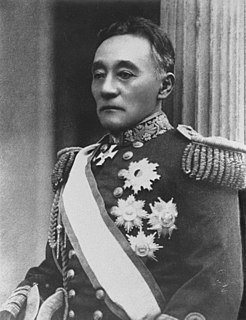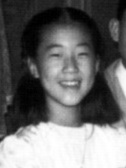
The emperor of Japan is the monarch and the head of the Imperial Family of Japan. Under the Constitution of Japan, he is defined as the symbol of the Japanese state and the unity of the Japanese people, and his position is derived from "the will of the people with whom resides sovereign power". Imperial Household Law governs the line of imperial succession. The emperor is immune from prosecution by the Supreme Court of Japan. He is also the head of the Shinto religion. In Japanese, the emperor is called Tennō, literally "Emperor of Kami" or "Heavenly Sovereign". The Japanese Shinto religion holds him to be the direct descendant of the sun goddess Amaterasu. The emperor is also the head of all national Japanese orders, decorations, medals, and awards. In English, the use of the term Mikado (帝/御門) for the emperor was once common but is now considered obsolete.

EmperorShōwa, commonly known in English-speaking countries by his personal name Hirohito (裕仁), was the 124th emperor of Japan, ruling from 25 December 1926 until his death in 1989. Hirohito and his wife, Empress Kōjun, had two sons and five daughters; he was succeeded by his fifth child and eldest son, Akihito. By 1979, Hirohito was the only monarch in the world with the title "emperor". He was the longest-reigning historical Japanese emperor and one of the longest-reigning monarchs in the world.

Japan was occupied and administered by the victorious Allies of World War II from the 1945 surrender of the Empire of Japan at the end of the war until the Treaty of San Francisco took effect in 1952. The occupation, led by the United States with support from the British Commonwealth and under the supervision of the Far Eastern Commission, involved a total of nearly 1 million Allied soldiers. The occupation was overseen by American General Douglas MacArthur, who was appointed Supreme Commander for the Allied Powers by US President Harry Truman; MacArthur was succeeded as supreme commander by General Matthew Ridgway in 1951. Unlike in the occupation of Germany, the Soviet Union had little to no influence over the occupation of Japan, declining to participate because it did not want to place Soviet troops under MacArthur's direct command.

The Imperial General Headquarters was part of the Supreme War Council and was established in 1893 to coordinate efforts between the Imperial Japanese Army and Imperial Japanese Navy during wartime. In terms of function, it was approximately equivalent to the United States Joint Chiefs of Staff and the British Chiefs of Staff Committee.
Washington State University is a public land-grant research university with its flagship, and oldest, campus in Pullman, Washington. Founded in 1890, WSU is also one of the oldest land-grant universities in the American West. With an undergraduate enrollment of 24,278 and a total enrollment of 28,581, it is the second largest institution for higher education in Washington state behind the University of Washington. It is classified among "R1: Doctoral Universities – Very high research activity".

The Shōwa era refers to the period of Japanese history corresponding to the reign of Emperor Shōwa (Hirohito) from December 25, 1926, until his death on January 7, 1989. It was preceded by the Taishō period. The pre-1945 and post-war Shōwa periods are almost completely different states: the pre-1945 Shōwa era (1926–1945) concerns the Empire of Japan, and post-1945 Shōwa era (1945–1989) is the State of Japan.

Bruce Cumings is an American historian of East Asia, professor, lecturer and author. He is the Gustavus F. and Ann M. Swift Distinguished Service Professor in History, and the former chair of the history department at the University of Chicago. He specializes in modern Korean history and contemporary international relations.

Yasuhito, Prince Chichibu, was the second son of Emperor Taishō (Yoshihito) and Empress Teimei (Sadako), a younger brother of Emperor Shōwa (Hirohito) and a general in the Imperial Japanese Army. As a member of the Imperial House of Japan, he was the patron of several sporting, medical, and international exchange organizations. Before and after World War II, the English-speaking prince and his wife attempted to foster good relations between Japan and the United Kingdom and enjoyed a good rapport with the British royal family. As with other Japanese imperial princes of his generation, he was an active-duty career officer in the Imperial Japanese Army. Like all members of the imperial family, he was exonerated from criminal prosecutions before the Tokyo tribunal by Douglas MacArthur.

Takahito, Prince Mikasa was a Japanese prince, the youngest of the four sons of Emperor Taishō (Yoshihito) and Empress Teimei (Sadako). He was their last surviving child. His eldest brother was Emperor Shōwa (Hirohito). After serving as a junior cavalry officer in the Japanese Imperial Army during World War II, Prince Mikasa embarked upon a post-war career as a scholar and part-time lecturer in Middle Eastern studies and Semitic languages.

Count Kawamura Sumiyoshi, was an admiral in the Imperial Japanese Navy. Kawamura's wife Haru was the aunt of Saigō Takamori.

George Tsutakawa was an American painter and sculptor best known for his avant-garde bronze fountain designs.
The Shandong Problem or Shandong Question was a dispute over Article 156 of the Treaty of Versailles in 1919, which dealt with the concession of the Shandong Peninsula. It was resolved in China's favor in 1922.

Atsuko Ikeda, formerly Atsuko, Princess Yori, is the fourth daughter of Emperor Shōwa and Empress Kōjun. As such, she is the older sister of Emperor Emeritus Akihito. She married Takamasa Ikeda on 10 October 1952. As a result, she gave up her imperial title and left the Japanese Imperial Family, as required by law. Later, she served as the most sacred priestess (saishu) of the Ise Grand Shrine between 1988 and 2017.

Takako Shimazu, born Takako, Princess Suga, is a former member of the Imperial House of Japan. She is the fifth and youngest daughter of Emperor Shōwa and Empress Kōjun, and the youngest sister of the Emperor Emeritus of Japan, Akihito. She married Hisanaga Shimazu on 3 March 1960. As a result, she gave up her imperial title and left the Japanese Imperial Family, as required by law.

Ikuhiko Hata is a Japanese historian. He earned his PhD at the University of Tokyo and has taught history at several universities. He is the author of a number of influential and well-received scholarly works, particularly on topics related to Japan's role in the Second Sino-Japanese War and World War II.
Patrick Lennox Tierney was an American Japanologist academic in the field of art history, an emeritus professor of the University of Utah, a former Curator of Japanese Art at the Utah Museum of Fine Arts, a former Director of the Pacific Asia Museum, and a former Commissioner of Art and Monuments during the Allied occupation of Japan (1945–1952).

Nip is an ethnic slur against people of Japanese descent and origin. The word Nip is an abbreviation from Nippon (日本), the Japanese name for Japan.
Carol Gluck is an American academic and Japanologist. She is the George Sansom Professor Emerita of History at Columbia University and served as the president of the Association for Asian Studies in 1996.

The history of China–Japan relations share a long history dating back thousands of years through trade, cultural exchanges, friendships, and conflicts. Japan has deep historical and cultural ties with China; cultural contacts throughout its history has strongly influenced the nation – including its writing system architecture, cuisine, culture, literature, religion, philosophy, and law.

Ramona Solberg (1921–2005) created eccentric yet familiar jewelry using found objects; she was an influential teacher at the University of Washington School of Art and often referred to as the "grandmother of Northwest found-art jewelry". She was an art instructor in and around Seattle for three decades as well as a prolific jewelry artist.















